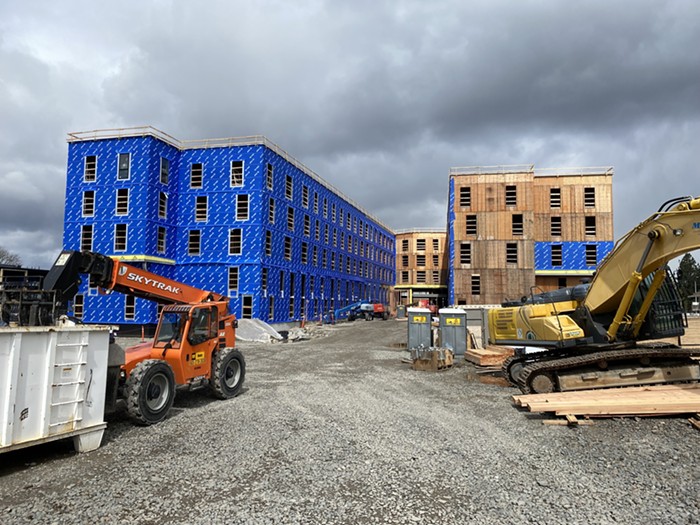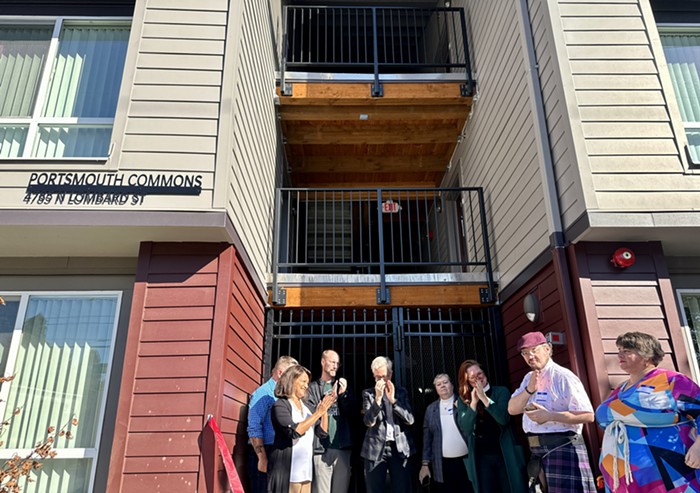
Residents' sense of control is key to a successful village for formerly homeless people, according to a study published by Portland State University (PSU) Tuesday. The study, a two-year analysis of "tiny pod villages" in the Portland region, offers one of the first in-depth analyses of the village model as a form of alternative shelter for unhoused people—a solution that's grown in popularity across the region and country in recent years.
While the report underscores that permanent housing is the main solution to homelessness, it concludes that villages are a reasonable housing alternative in the interim. Along with detailing data collected from local villages, the report acts as a guide for others interested in operating their own village.
"This research gives cities a full picture of what a village is and best practices informed by people with experience living in villages, working in villages, designing villages and organizing villages," said Todd Ferry, one of the project's lead researchers, in a press release. "I hope it will be a resource that leads to better outcomes for those living in villages."
Researchers described Portland as an "ideal" city to study this type of alternative shelter, as its home to one of the first and longest running villages, Dignity Village. Since Dignity Village's creation in 2000 by unhoused Portlanders, the region has seen nearly a dozen other villages pop up—some by formerly homeless residents, others by nonprofits or city governments. The PSU study looked at six villages in particular: Dignity Village, Hazelnut Grove, Kenton Women's Village, Clackamas County Veteran Village, Agape Village, and St. John's Village. Each of these villages differ in their layout, leadership style, on-site offerings, and structures.
The study found that the vast majority of village residents are happy living in a pod village, with most of them preferring to live in one where they can have input on community decisions.
“Giving villagers a voice and sense of agency over how villages operate had a huge impact on villager satisfaction,” said Ferry. “It didn’t have to be a full self-governance model, but just a clear way that they were involved in decisions.”
The villages surveyed range from being completely governed by villagers, like Hazelnut Grove, to be completely operated by a nonprofit, like the Kenton Women's Village.
"Whether at a self-governed village or a managed village, having a voice in the way the village functions is crucial for ensuring satisfaction among the villagers," the report reads. The study suggests that villages have a couple staff members in place to be responsible for site management, security, or possibly helping connect villagers to social service needs.
Villagers also told researchers that they were most comfortable in villages home to between 20 to 30 residents.
Researchers also found that several people who lived in homes near villages had concerns about the behavior of village residents before it was in operation—but those fears plummeted once the village opened. Neighbors also raised alarm about how their home's proximity to a village could impact their property value and could increase crime, but researchers were unable to find conclusive data to confirm or deny these threats.
The study identified several downsides of local villages. In particular, researchers found that 45 percent of the villagers they interviewed said they were food insecure, meaning they didn't have reliable access to healthy and affordable food. Researchers also observed that white men were disproportionately represented in village populations, with only 17 percent of the villagers interviewed identifying as Black, Indigenous, or other people of color (colloquially known as BIPOC). The most recent point-in-time count of unsheltered homeless people living in Multnomah County found that 40 percent of those counted were people of color.
“The village model, when implemented thoughtfully, serves an important response to alternative shelter, but questions still remain about the model’s racial equity," said researcher Marisa Zapata, who serves as the director of PSU's Homelessness Research & Action Collaborative (HRAC).
Researchers found that villages that are staffed or supported by people of color are more likely to have people of color as residents. As an example: "Kenton Women’s Village went from all white to consisting of 50 percent people of color when a Black woman joined the village management, and the intake process began to include race as a significant factor in their system for evaluating applicants," the report reads.
The study recommends villages involve people of color early on in the design process to guarantee the space reflects their needs. It also encourages the idea of creating villages specifically for people of color, like the city has done with the Creating Conscious Communities with People Outside (C3PO) BIPOC encampment.
"The same systemic structures of racism and inequity need to be confronted and addressed in order to create villages that truly support people of color," the report reads.
The report drops as the city is preparing to launch its Safe Rest Village program, which will create six new outdoor tiny pod villages across Portland. The city's model will closely resemble the structure of St. John's Village, which is overseen by the Joint Office of Homeless Services (JOHS) and managed by a nonprofit. One of the Safe Rest Villages will be an open parking space for people who live in RVs and cars. The PSU report did not analyze any vehicle-based villages.

















